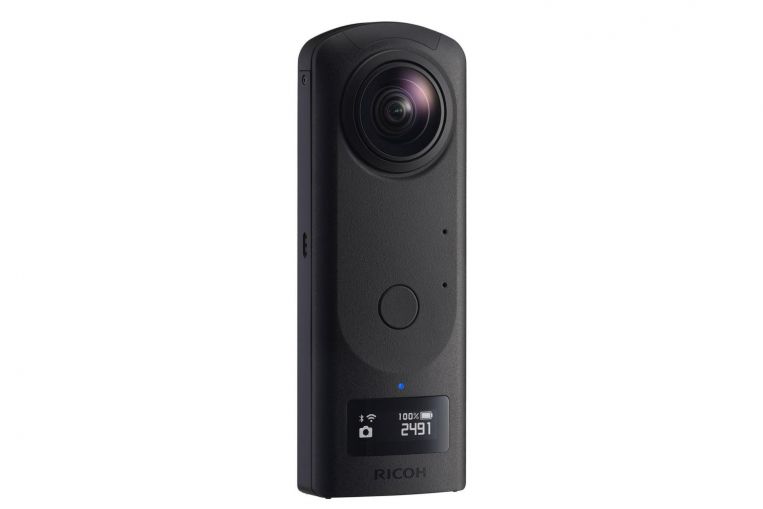The Z1 is the latest model in Ricoh’s Theta 360-degree camera series. It succeeds the Theta V, which was launched in 2017.
The most touted feature is its two 1-inch back-illuminated 20-megapixel CMOS image sensors. These are the biggest image sensors yet in a 360-degree camera and a major improvement over its predecessors’ 1/2.3-inch sensors.
This means that, theoretically, the Z1 should shoot better images as it can capture more light and thus more details. In addition, the camera can shoot 360-degree RAW photos for more flexibility in post-processing.
With the bigger image sensors, the Z1 is around 7mm thicker and 60g heavier than its direct predecessor.
In terms of design, the Z1 does not differ much from its predecessors. It still has a candy-bar body and a 180-degree lens each on its front and back. But the body feels more sturdy with its magnesium-alloy shell.
A new addition is a small display in front – sited under the shutter-release button – to show important information like battery percentage, shooting mode and wireless mode.
There is one more button on the Z1’s side than the V’s, with the new Function button added to the Power, Mode and Wireless buttons.
The headphone jack and micro-USB port found on the V’s bottom are gone. At the Z1’s bottom are a USB-C port for the charging and transferring of images, as well as a tripod mount hole that is also present in the V.
With the two 20-megapixel image sensors and two 180-degree lenses, the Z1 produces 23-megapixel 360-degree still images. It supports 4K (3,840 x 1,920 pixels) 360-degree video recording at up to 30 frames per second (fps) as well as 4K 360-degree live streaming.
You can shoot blindly by pressing the shutter-release button. You can also use the Theta app (available on Android and iOS) to do so, which allows you to use the app as a remote viewfinder. The app also gives you more shooting options such as the high dynamic range (HDR) mode and noise reduction.
The 360-degree stills, especially those in the RAW format, are superb with great sharpness and plenty of details. They are probably the best stills I have seen from a consumer 360-degree camera.
With the HDR mode turned on, the dark areas are illuminated nicely with clear details, while the bright skies are not overexposed. This is the mode to use if you are shooting 360-degree landscapes.
The 4K 360-degree videos are a marked improvement over those shot with the V. The lighting is more accurate and less noisy. However, the stitching line can be clearly seen at times. Note that the Theta app does not have the multiple-angles video editing function found in the likes of the Insta360 One X app.
Not to mention, the Z1’s internal storage remains at 19GB with no increase from its predecessor. That means you can only get 40 minutes of video footage.
There is also no microSD card slot. Given Z1’s bigger image sensors, it really makes no sense not to include a microSD card slot to expand the storage.
Like most digital cameras, the Theta Z1’s battery life is average, at around 300 still images or 60 minutes of video footage on a full charge.
Pricing though is the Z1’s biggest downer. At $1,438, it is more than twice the price of a Theta V. In fact, you can buy two sets of the Insta360 One X 360-degree camera bundle with that amount of money.
FOR
– Superb 360-degree still images
– High dynamic range mode works great for stills
– Able to shoot RAW still images
AGAINST
– No memory card slot
– Limited built-in memory
– Expensive
TECH SPECS
PRICE: $1,438
IMAGE SENSOR: 2x 20-megapixel 1-inch CMOS x 2
LENS: 2 x 180 degrees f/2.1
SENSITIVITY: ISO 80 to 6,400
CONNECTIVITY: Bluetooth, Wi-Fi
WEIGHT: 182g
RATING
FEATURES: 4/5
DESIGN: 4/5
PERFORMANCE: 4/5
BATTERY LIFE: 3/5
VALUE FOR MONEY: 3/5
OVERALL: 4/5
Source: Read Full Article
